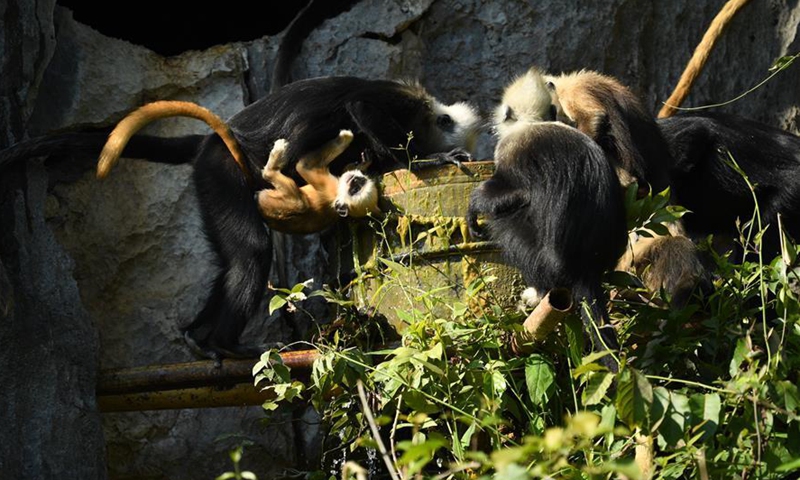Endangered monkeys retrieve paradise in China's karst village
Source: Xinhua Published: 2020/9/2 9:25:33

A white-headed langur forages on a hillside in the Banli subarea of the Guangxi Chongzuo national nature reserve in Chongzuo City, south China's Guangxi Zhuang Autonomous Region, July 13, 2020. (Photo by Wu Shujun/Xinhua)
In the city of Chongzuo, south China's Guangxi Zhuang Autonomous Region, limestone peaks jut up from lush sugarcane fields, where the farmers love to keep an eye for white-headed langurs, one of the rarest primates on Earth.
Once driven to the brink of extinction due to excessive hunting and habitat loss with only about 300 remaining in Chongzuo, the monkeys are thriving again with special care from locals. Chongzuo is deemed the exclusive habitat of the species. UNIQUE CREATURE
Wu Xiaolan, a resident in Qunan, a hamlet tucked in the lowland of Karst hills in Chongzuo, had never heard of the species before marrying there in the mid-1990s. She fell for the monkeys at first sight.
"I still remember the thrill of watching a monkey mother carrying two golden babies in her arms, or an entire herd leaping over the crags. My only regret is that I couldn't capture their images as there were no smartphones back then," said Wu.
White-headed langurs are born with strikingly golden-orange fur. The adults possess a blackish hue, giving a sharp contrast to its white head and shoulder. The palette helps them blend well into the color of Karst hills, its natural habitat.
About 90 percent of the creature lives in four isolated regions of the Guangxi Chongzuo national nature reserve. Each family occupies a cluster of hills, with tree leaves being their primary source of food.
The animal was listed as critically endangered by the International Union for Conservation of Nature. And it is classified as a national first-class protected animal in China.

White-headed langurs drink water in the Banli subarea of the Guangxi Chongzuo national nature reserve in Chongzuo City, south China's Guangxi Zhuang Autonomous Region, Dec. 3, 2019. (Photo by Wu Shujun/Xinhua)
STRINGENT PROTECTION
In the late 1980s, poaching had been rampant as hunting with traps and shotgun was still prevalent, and bones of white-headed langurs were coveted for medical purposes.
Meanwhile, some farmers worrying about wildlife intrusion would set up spring-powered, steel-jaw traps around their farmland.
Tang Lifeng, a local Zhuang ethnic, has served as a ranger in the reserve for 37 years. His team of two to three rangers treks up to 30 km, mostly in the dense and muggy bush, thrice every week.
"In the past 30 years, we've rescued at least six trapped white-headed langurs," said Tang.
On their trekking route, they look out for unlawful activities such as poaching, unauthorized trenching, and lumbering, and check the status of various wildlife including white-headed langurs.
"Sometimes we stay in the bush for a while to count monkey heads and tails and record their demographic changes," he said.
With technological assistance such as infrared cameras, remote monitoring system and drones, rangers could have a better grasp of such aspects, he noted.
Rangers would receive satellite remote sensing images from the local forest department if any anomaly occurs in the reserve, allowing them to inspect the site much quicker.
Due to strict enforcement of conservation policies, the reserve reported zero cases of poaching of white-headed langurs in the past decade.
Besides, the population of langurs in Chongzuo surged from around 300 in the 1980s to more than 1,300, consisting of more than 130 subgroups.
The local forest department has ensured that each hamlet has at least one part-time ranger, allowing the folks to report animal activities and curb poaching, among other urgent tasks.
In the late 1980s, local villagers used to prepare spring cultivation using the slash-and-burn technique to increase soil fertility, which may cause forest fire threatening wildlife habitats.

White-headed langurs rest outside a Karst cave in the Banli subarea of the Guangxi Chongzuo national nature reserve in Chongzuo City, south China's Guangxi Zhuang Autonomous Region, Nov. 3, 2019. (Photo by Wu Shijun/Xinhua)
However, as sugarcane plantation started thriving in the mid-1990s, it generated more income for the locals, making poaching less alluring and slash-and-burn agriculture less popular as sugarcane is also easily combustible, said Zhang Kairong, a farmer and part-time ranger in Qunan.
The central government has also pushed for stricter legislation and law enforcement and raised public awareness in safeguarding a healthy ecosystem, Zhang added. THRIVE IN COEXISTENCE
Since 2010, more monkeys settled in the back hills of Qunan as local residents initiated voluntary actions to protect the animal and the environment.
Villagers have set up a team of volunteer rangers and opened nature awareness camps. Local children are encouraged to regularly collect trash in public areas.
Wu Xiaolan and her fellow female farmers offer eco-friendly guide services to visitors interested in white-headed langurs.
Meanwhile, the reserve has been exploring feasible ways to solve habitat fragmentation caused by existing farmlands and roads spreading beneath the hills.
Habitat fragmentation is likely to intensify inbreeding, lowering the genetic diversity of the species, said Wu Jianbao, head of the reserve.
The reserve, therefore, built two "corridors," which were constructed with reinforced concrete and rails to prevent monkeys from being hit by vehicles, or using plants favored by the monkeys to guide their migration.
"The corridors are expected to restore connectivity between habitats and facilitate the migration of monkey population more safely," said Wu.
Posted in: CHINA,ENVIRONMENT